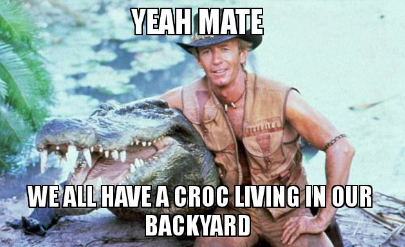Walking away from the first lesson of BCM330, I had some extensive discussions revolving around the Australian TV and Film industry and realised I had not given much thought to this topic prior to taking this class. It was made clear within the first hour that judging from the responses from my fellow classmates, our knowledge of the screen content produced in our own country is very limited. A mindmap was drawn up which was made up of all the things we associate Australian content with, this included Bogans, pubs, bad accents, scenic views, outback life, Aussie slang, the working class and wildlife, just to name a few. I think it is pretty safe to say that Australian audiences have bound up Australian films and TV into one genre involving a bunch of stereotypical icons that leave us with a bad taste of cringe-worthy and unrelatable content. 
The book ‘film-induced tourism’ written by Sue Beeton (2005) discusses how most of the famous Australian icons were developed through film and TV and seeing as though they have become the main mass media outlet they are an extremely useful source for advertising for tourism purposes. The assumption that specifically the films produced in Australia are made for international audiences rather than local audiences is one based on the premise of study and not just an opinion. Furthermore, Screen Australia states that in order for a project to receive the funding it must contain cultural benefits or in other words ‘Significant Australian Content’ (2009). As much as I agree that some of the ways our culture is portrayed in a variety of movies are repetitive and predictable, it is important to understand that the producers of these Australian films have a set of guidelines to follow ensuring there is a sense of “Australianess” within the final product, Tv has similar guidelines and my opinion is the difference in television is it is done better.
In 1958 Senator Victor Vincent submitted a report to the Australian Government, most commonly recognised as the ‘Vincent Report’, that addressed his consuming concern that Australian audiences were exposed to an Americanised TV agenda and underexposed to Australian content, jeopardising the acceptance of local productions and so consequently a lacking in avenues for creative expression. The report was not accepted by the government at the time it was submitted but post-1960s played an important role in influencing the notion to produce more quality Australian TV. Television in Australia has catered to a broader range of age groups, reality tv especially taking off grabbing the attention of younger audiences with shows like Survivor, The Block and My Kitchen Rules. In 2016 reality TV shows snagged 50% of the top 50 programs tuned into by Australian Audiences. Longtime reality TV show Bondi rescue, reeling in a 7.8 out of 10 rating on TV.com, most likely gaining the support of Australian audiences because it is a show which successfully portrays a big part of many people’s lives in Australia, the beach! Exploring all sides of beach culture including the extreme danger of the ocean, which is very much relatable to the way we live (ditches the overdrive of sugar coating!). In her published journal article ‘Reinforcing the myth: Constructing Australian Identity in Reality TV”, Emma Price explains that ‘Bondi Rescue’ was a refreshing program for local audiences as it shifted away from the ‘bush’ identity commonly explored in many Australian programs (2010,p.454). The beach holds a special place in the Australian identity so revolving a TV show around the truths of such a place was appreciated and intriguing for both locals and foreigners.
The real success of Australian screen productions lies in our TV industry. Programs aired weekly on our TV sets are examples of identifiable images of Australianess (Price 2010, p.454), straying from the bore of stereotypical storylines. The Australian Broadcasting Corporation (ABC) is a perfect example of quality 21st-century entertainment produced locally and proudly. The non-commercial TV channel supports our production industry offering Australians a variety of shows, without the ads! I know it’s starting to sound like an ad now (free of charge, no worried ABC) but how could you not appreciate a network who brought Kath & Kim and Playschool into our lives. Summing up why we need Australian Screen production houses like the ABC couldn’t be said any better; ‘quality entertainment that contributes to our national culture and allows our voices to be heard and stories to be told’.
Have a little faith fellow Aussies, be creative, watch some TV, explore the deep wide web because you will find great content, trust me why won’t you.
References
- Beeton, S 2016, Film-induced tourism: 2nd edition, Channel view publications, UK.
- Price, E 2010, ‘Reinforcing the myth: Constructing Australian identity in ‘reality TV”, Continuum: Journal of Media & Cultural studies, vol. 24, no. 3, pp. 451-459.
Wk 1 blog
